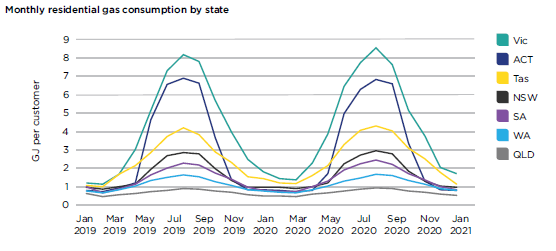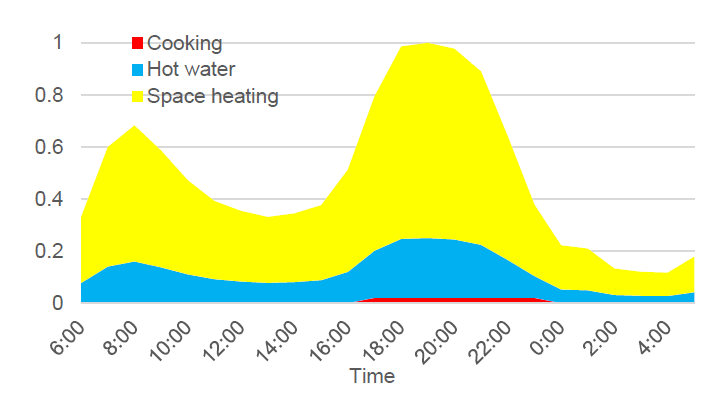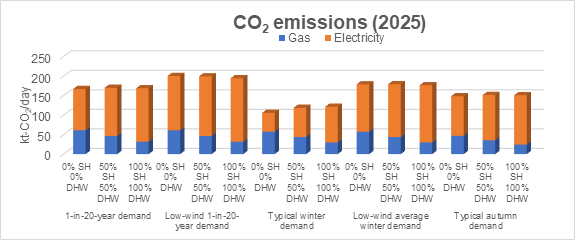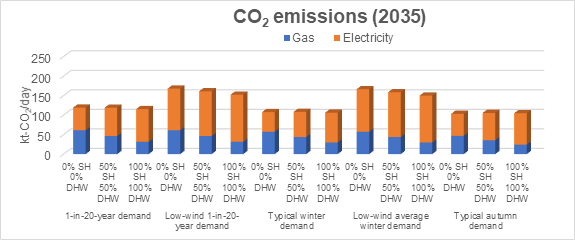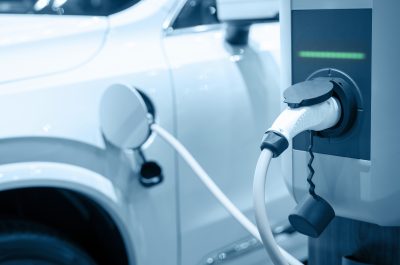What to do when electrification will increase emissions
Across Australia, heating is the main use of gas in households and demand for gas in winter is much higher than the demand in summer. Out of all the states and territories, Victorians consume the most gas per household.
Figure 1: Monthly residential gas consumption by state (Source: Energy Networks Australia (2021), Reliable and clean gas for Australian households)
During winter, the daily usage of gas peaks between 7 and 9 in the morning and between 5 and 9 in the evenings. This usage can be up to three times higher than during the middle of the day. By taking an average of gas consumption across the day, we lose an understanding of how gas in consumed throughout a 24 hour period. Time of use is commonly applied in electricity to help manage peak demand and manage costs, as the wholesale price of electricity generally increases during these peak periods. Gas networks and infrastructure (with their inherent storage characteristics) are already built and working to meet these daily and seasonal fluctuations.
Emissions reductions from energy use is key. Work is well underway to replace the use of gas with renewable gases such as hydrogen or biomethane.
Figure 2: Normalised residential gas demand profile for a typical winter weekday (source: FFCRC (2019), RP1.1-02: Regional case studies on multi-sector integration – electrification of heating)
An alternate option is to electrify the use of gas. For any electrification argument to make sense, savings in greenhouse gas emissions needs to be demonstrated. This is often done by combining facts about nominal heat pump efficiency and an average contribution of renewables for electricity generation.
Unfortunately, electrification falls short on the emissions front. Especially in Victoria, where the majority of electricity is produced from brown coal, this will continue for quite some time.
Electrification in 2025 increases emissions
An integrated electricity and gas system model for Victoria developed by a Future Fuels CRC research team, led by Professor Pierluigi Mancarella at The University of Melbourne, provides a better understanding of the systems impact of electrification of residential heating in Victoria on both electricity and gas systems.
The year 2025 was used as the base year for modelling. This had the same gas demand as 2020 but with a higher level of renewable electricity generation[i]. Only Victoria’s residential load of 49 per cent was electrified as the remaining 51 per cent is for industrial and commercial consumption. The model considered options where both space heating and hot water are electrified at either 50 or 100 per cent. The model determined the efficiency of heat pump appliances and their changing performance in colder weather, the time of use and the marginal emission intensity of electricity at that time of day and then calculated the generation mix and the total daily emissions in each scenario.
The increasing demand of generation during peak times – on a typical winter day in 2025 – is firstly met by more coal fired generation, and then by gas, hydro and imports from other regions.[ii]
Figure 3: Generation profile in Victoria for electrification increase from 0 to 50 to 100 per cent for a typical winter day in 2025 (Source: FFCRC – RP1.1-02)
The model calculated an increase in emissions at higher levels of electrification. This reflects reduced gas consumption in households but that was offset by an increased level of coal and gas peaking generation to provide the increased electricity demand from electrification. For a typical winter day, the emissions increased by 12 per cent for a 50 per cent level of electrification and increased by 15 per cent for a 100 per cent level of electrification. The remaining emissions from gas are due to the gas being used for commercial and industrial purposes.
Figure 4: Greenhouse gas emissions from electrification of residential gas appliances in 2025 (Source: FFCRC, RP1.1-02)
Electrification in 2035 does not change emissions
The scenarios were repeated for the year 2035, to account for Victoria’s 50 per cent renewable energy target and the closure of Yallourn power station.
Given brown coal generation is already close to maximum at peak times in 2035, an increase in electrification increases both the levels of peaking gas plant and imports. There is an increased amount of renewable generation compared to 2025. The result is that the overall emissions by 2035 are the same on a typical winter day whether gas is used in the home directly, or those services are electrified.
Figure 5: Greenhouse gas emissions from electrification of residential gas appliances in 2035 (Source: FFCRC, RP1.1-02)
Implications for policy
Increasing the amount of renewable generation is a priority to achieve emission reductions. It’s not only the average levels that count, but the absolute levels at any time of the day that are really important.
The systems modelling shows the potential for policy driven electrification – via either subsidies to the installation of heat pumps or restricting growth of gas networks – will result in increased CO2 emissions. It is not until 2035 when both options reach the same level of emissions.
[i] As per AEMO Integrated System Plan (2020)
[ii] The researchers also tested the sensitivity of lower-than-normal wind generation and a 1-in-20 year demand. These are described in detail in the published research report at www.futurefuels.com
